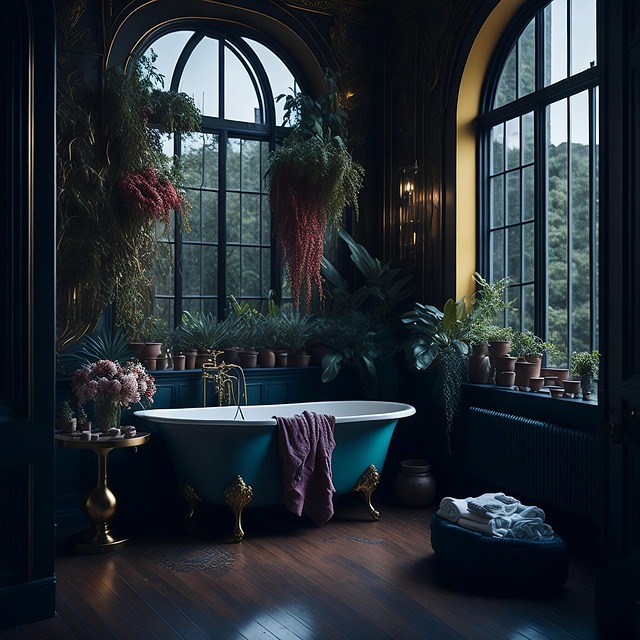In humid bathrooms, selecting safe floor covering is crucial. Slip-resistant options like vinyl and ceramic tile prevent accidents by repelling moisture and enhancing traction. Vinyl is durable and easy to maintain, while porcelain tiles offer superior water resistance for high-traffic areas. Installation requires a level subfloor and proper adhesives, with regular maintenance focusing on dryness and pH-neutral cleaning. Modern trends provide diverse, stylish options while meeting safety needs in bathrooms, ensuring comfort and security for all users.
“Elevate your bathroom experience with the ultimate guide to water-resistant, slip-resistant flooring. Discover why this is an essential upgrade for any home, especially high-moisture spaces. From safety concerns to aesthetic appeal, we explore various flooring types tailored for bathrooms, offering durability and a non-slip grip. Learn about installation best practices and maintenance tips to ensure longevity. Get inspired with design ideas that merge functionality and style, transforming your bathroom into a safe, modern sanctuary.”
- Understanding the Need for Water-Resistant Flooring in Bathrooms
- Types of Slip-Resistant Bathroom Flooring Options
- Installation and Maintenance Tips for Longevity
- Design Ideas to Create a Stylish and Safe Bathroom Space
Understanding the Need for Water-Resistant Flooring in Bathrooms
In the humid and often slippery environment of bathrooms, choosing the right floor covering is paramount for safety and aesthetics. Traditional flooring materials like wood or carpeting can quickly become hazardous when exposed to water, leading to slips and falls. This is where slip-resistant bathroom flooring becomes essential—it offers a protective layer that enhances safety without compromising style.
Water-resistant flooring options are designed with special coatings or construction that repels moisture, preventing water from seeping into the underlying surface and causing damage. Moreover, these floors provide better traction compared to standard tiles or linoleum, significantly reducing the risk of accidents in one of the busiest and most susceptible rooms in any home.
Types of Slip-Resistant Bathroom Flooring Options
When it comes to choosing floorings for bathrooms, especially in areas with high moisture levels, selecting a slip-resistant option is paramount to ensure safety and prevent accidents. There are several types of slip-resistant bathroom flooring options available that offer both functionality and aesthetic appeal. Vinyl flooring, for instance, has gained immense popularity due to its water resistance, durability, and ease of maintenance. It comes in various styles, from tiles to sheets, allowing for creative design possibilities while providing a secure surface.
Another excellent choice is ceramic tile flooring, renowned for its longevity and ability to withstand moisture. Not only does it add a touch of elegance to any bathroom, but it also offers excellent traction due to its natural non-slippery surface. Porcelain tiles are especially recommended for high-traffic areas as they are more dense and less porous than traditional ceramic tiles, making them even more water-resistant.
Installation and Maintenance Tips for Longevity
When installing water-resistant flooring in your bathroom, ensure a level subfloor for a secure fit. Use appropriate adhesives and sealants to lock down the flooring, following manufacturer guidelines strictly. For best results, consider hiring professionals who can handle the intricate process of installing slip-resistant bathroom flooring. Regular maintenance is key to longevity. Keep the area free from standing water after showers or baths. Use floor mats at entry points to minimize moisture transfer from outside. Avoid harsh chemicals and abrasive cleaners which can damage the surface. A quick sweep or mop with a pH-neutral cleaner will usually suffice in keeping your water-resistant flooring in pristine condition.
Design Ideas to Create a Stylish and Safe Bathroom Space
When designing a stylish yet safe bathroom space, especially for high-traffic areas like shower stalls and around sinks, incorporating water-resistant and slip-resistant flooring is non-negotiable. Opting for materials that offer both aesthetics and safety ensures your bathroom remains a comfortable and secure environment for all users. Modern trends in bathroom flooring cater to diverse design tastes while meeting functional requirements.
For a contemporary look, consider tiles with intricate patterns or sleek, smooth vinyl that mimics the elegance of wood or stone without compromising on durability. Textured options, often infused with anti-slip technology, add visual interest while enhancing traction, making them ideal for wet conditions. Additionally, recent advancements in flooring materials have led to innovative designs like waterproof luxury vinyl planks (LVP) and ceramic tiles with built-in slip-resistance, offering both performance and style in equal measure.
When choosing flooring for your bathroom, prioritizing water resistance and slip-resistance is key to creating a safe, stylish space. By understanding your options, proper installation, and regular maintenance, you can ensure a durable and attractive floor that enhances your bathroom’s overall aesthetic while mitigating potential hazards. Opting for slip-resistant bathroom flooring is a smart investment in both functionality and long-lasting design.
